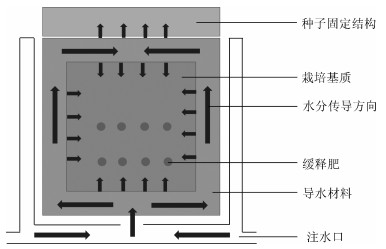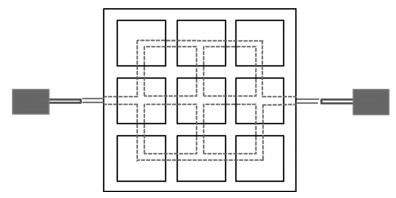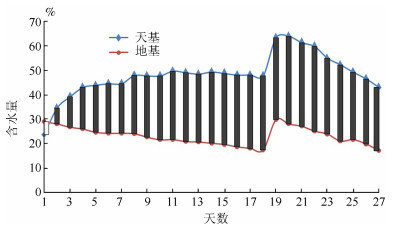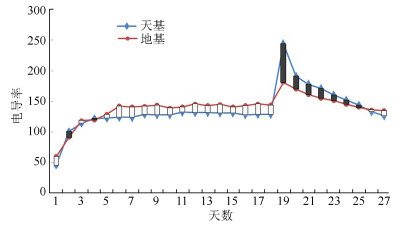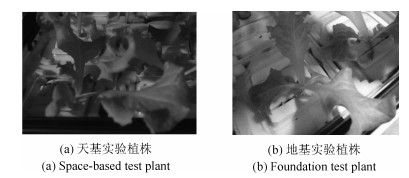Investigation on Water and Nutrition Control of Plant Growth Under Microgravity in Space
-
摘要: 通过"天宫2号"空间实验室搭载的空间植物栽培装置,研究了微重力下植物栽培水分养分控制技术.针对空间微重力特点,设计了植物栽培水分养分传导结构,并验证了其可行性和合理性.生菜在空间实验室微重力环境下的顺利萌发、生长发育,证明了水分养分传导结构的合理性和可行性,为后续开展更大规模的空间植物栽培奠定了基础.通过实验,了解了空间微重力下水分养分的传导和分布规律,为研究空间植物栽培水分养分供应方法和测试方法提供了依据.Abstract: With the help of the space plant growth facility in Chinese Spacelab Tiangong 2, the water and nutrition control technology for plant growth under microgravity environment is investigated. Considering the microgravity environment, a special water and nutrition conduction structure is designed and its feasibility and rationality are proved by the successful germination and growth of lettuce. This test has laid a foundation of larger-scale space plant growth and helped to understand the laws of water and nutrition conduction and distribution under microgravity. This investigation provides a basis for the research on water and nutrition supply and measurement methods in space.
-
Key words:
- Space plant growth facility /
- microgravity /
- water and nutrition control /
- spacelab
1) 本文责任编委 辛景民 -
表 1 实验条件设置
Table 1 Test condition setting
参数类别 参数范围 大气温度 23 $^{\circ}$C $\pm$ 0.5 $^{\circ}$C 大气相对湿度 $50 \% \pm 5 \%$ 大气压力 常压 大气氧浓度 $20.9 \% \pm 0.5 \%$ 大气二氧化碳浓度 0.2 %$\sim$ 0.4 % 植物光照条件 光源为红蓝绿发光二极管(LED),红蓝绿三色比例$8:1:1$; 光照周期为14 hr(亮)/8 hr (暗) 生长周期 29天 表 2 空间植物栽培装置达到的主要性能指标
Table 2 Main performance indicators of space plant cultivation device
类别 项目名称 主要性能指标 空间植物栽培装置 大小 长方体结构包络尺寸L(268 mm) $\times$ W(268 mm) $\times$ H(306 mm) 重量 5.8 kg (含所有相关配套测试设施及物品) 功耗 峰值16.4 W 栽培单元 1)栽培面积: $0.045 {\rm m}^2$ 2)可栽培株数: 9株 3)栽培基质+导水材料:蛭石+棉质纱布 4)水分管理:具备加水管路, 栽培盒左右两侧可分别进行栽培基质含水量测量, 测量范围0 $\sim$ 100 %, 测量精度±3 %. 5)养分管理:采用长效缓释肥颗粒进行养分供应, 栽培盒左右两侧可分别进行栽培基质电导率测量, 测量范围0 $\sim$ 300 mS/m, 测量精度±0.3 mS/m. 6)种子固定结构:具备2个细缝、1个大圆孔和2个小圆孔等三种固定种子的结构形式. 7)固定盖板:安装固定在在种子固定结构上, 具有9个苗孔; 可方便拆卸. 光照单元 1)光源: LED灯 2)光质:红、蓝、绿比例约为8 : 1 : 1 3)光强:光源正下方5 cm处平均达到105 μmol$ \cdot {\rm m}^{-2}\cdot {\rm s}^{-1}$. 4)光源功率: 13.5 W 5)光周期: 0 $\sim$ 24 hrs手动可调 生长单元 1)四面由立柱和透明有机玻璃制成, 立柱具备长、短两种类型, 可方便更换. 2)在长立柱条件下四周可开放也可密封. 测量单元 1)可进行栽培基质中含水量和电导率的手动监测, 含水量测量范围0 $\sim$ 100 %, 电导率测量范围0 $\sim$ 300 mS/m. 2)装置封闭条件下可手动进行大气CO$_2$浓度监测, 测量范围0 $\sim$ 5 000 ppm, 分辨率1 ppm. 保障单元 具备自主通风组件和12 V直流供电电源接口. 整体设计及接口要求 1)采取了模块化设计, 可方便拆卸、折叠、绑扎、悬挂或固定. 2)结构采用了轻质、无毒无害和非易燃的非金属材料. 3)具有安装机械接口和直流供电电源接口. 4)具备较好的工效学设计. 表 3 缓释肥成分配比
Table 3 Ingredient ratio of slow release fertilizer
成分 质量分数(%) 氮 NO3-N 9 NH4-N 11 磷 水溶性P 6.2 枸溶性P 1.8 钾 10 硫 4 钙 2 镁 0.2 铁锰铜锌硼 0.08 表 4 天基和地基同步对照实验发芽情况统计
Table 4 Germination statistics of space-based and ground-based synchronous controlled trials
实验类别 发芽结构类别 发芽个数/播种个数 发芽率 天基实验 切缝结构 33/99 37 % 圆孔+海绵 11/45 24 % 小圆孔+大粒化 0/18 0 % 地基同步对照实验 拉缝 65/90 72 % 圆孔+海绵 29/45 64 % 小圆孔+大粒化 5/18 28 % -
[1] Salisbury F B. Growing crops for space explorers on the moon, Mars, or in space. Advances in Space Biology and Medicine, 1999, 7:131-162 doi: 10.1016/S1569-2574(08)60009-X [2] Wheeler R M, Stutte G W, Subbarao G V, Yorio N C. Plant growth and human life support for space travel. Handbook of Plant and Crop Physiology (Second Edition). Boca Raton, FL, USA:CRC Press, 2001. 925-942 [3] Tibbits T W, Alford D K. Controlled ecological life support system:use of higher plants. In:Proceedings of the NASA Conference Publication 2231. California, USA:NASA, 1982 [4] Guo S S, Tang Y K, Gao F, Ai W D, Qin L F. Effects of low pressure and hypoxia on growth and development of wheat. Acta Astronautica, 2008, 63(7-10):1081-1085 doi: 10.1016/j.actaastro.2008.02.006 [5] Tikhomirov A A, Ushakova S A, Kovaleva N P, Lamaze B, Lobo M, Lasseur C. Biological life support systems for a Mars mission planetary base:problems and prospects. Advances in Space Research, 2007, 40(11):1741-1745 doi: 10.1016/j.asr.2006.11.009 [6] Nelson M, Dempster W F, Allen J P. Key ecological challenges for closed systems facilities. Advances in Space Research, 2013, 52(1):86-96 doi: 10.1016/j.asr.2013.03.019 [7] Halstead T W, Dutcher F R. Plants in space. Annual Review of Plant Physiology, 1987, 38:317-345 doi: 10.1146/annurev.pp.38.060187.001533 [8] Ferl R, Wheeler R, Levine H G, Paul A L. Plants in space. Current Opinion in Plant Biology, 2002, 5(3):258-263 doi: 10.1016/S1369-5266(02)00254-6 [9] Wolff S A, Coelho L H, Zabrodina M, Brinckmann E, Kittang A I. Plant mineral nutrition, gas exchange and photosynthesis in space:a review. Advances in Space Research, 2013, 51(3):465-475 doi: 10.1016/j.asr.2012.09.024 [10] Berkovich Y A, Krivobok N M, Sinyak Y Y, Smolyanina S O, Grigoriev Y I, Romanov S Y, et al. Developing a vitamin greenhouse for the life support system of the international space station and for future interplanetary missions. Advances in Space Research, 2004, 34(7):1552-1557 doi: 10.1016/j.asr.2004.06.006 [11] NASA. Meals ready to eat:expedition 44 crew members sample leafy greens grown on space station. 2015 https://phys.org/news/2015-08-meals-ready-crew-members-sample.html [12] NASA. Zinnia flowers starting to grow on the international space station. 2015 https://www.nasa.gov/image-feature/zinnia-flowers-starting-to-grow-on-the-international-space-station [13] NASA. First flower grown in space station's veggie facility. 2016 https://www.nasa.gov/image-feature/first-flower-grown-in-space-stations-veggie-facility [14] NASA. Flowering zinnias on space station set stage for deep-space food crop research. 2016 https://www.nasa.gov/feature/flowering-zinnias-on-space-station-set-stage-for-deep-space-food-crop-research [15] Morrow R C, Remiker R W, Mischnick M J, Tuominen L K, Lee M C, Crabb T M. A low equivalent system mass plant growth unit for space exploration. SAE Technical Paper 2005-01-2843, 2005 [16] Loff S. Zinnia flowers starting to grow on the international space station. 2015 https://www.sae.org/publications/technical-papers/content/2005-01-2843/ [17] Bingham G, Jones S B, Podolsky I, Yendler B S. Porous substrate water relations observed during the greenhouse-2 flight experiment. SAE Technical Paper 961547, 1996 [18] Fukaki H, Fujisawa H, Tasaka M. How do plant shoots bend up? The initial step to elucidate the molecular mechanisms of shoot gravitropism using Arabidopsis thaliana. Journal of Plant Research, 1996, 109(2):129-137 doi: 10.1007/BF02344538 [19] Halstead T W, Dutcher F R. Plants in space. Annual Review of Plant Physiology, 1987, 38(1):317-345 doi: 10.1146/annurev.pp.38.060187.001533 [20] 赵琦, 刘敏, 蔡伟明.模拟微重力条件对植物幼苗生长的影响.植物生理学报, 2000, 26(3):201-205 doi: 10.3321/j.issn:1671-3877.2000.03.005Zhao Qi, Liu Min, Cai Wei-Ming. Effects of simulated microgravity on the growth of plant seedlings. Acta Phytophysiologica Sinica, 2000, 26(3):201-205 doi: 10.3321/j.issn:1671-3877.2000.03.005 -




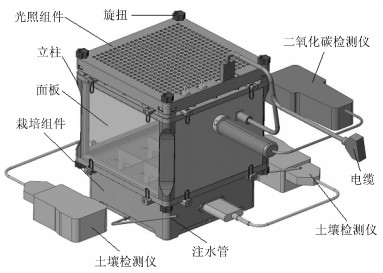
 下载:
下载:
